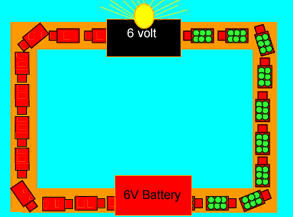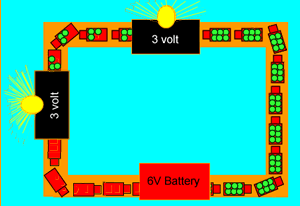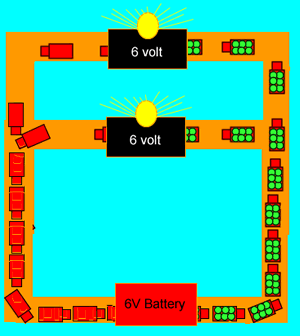
The animation above shows miniature trucks carrying bags of energy from the battery to a light globe. The light globe takes the bags of energy and uses this energy to glow.
When returning to the battery the trucks have no more bags of energy. Each truck has lost 6 bags of energy as it moves through the light globe.
Now consider each truck to be an electron carrying energy or voltage given to it by the battery. The flow of trucks, or electrons, along the road is called a current.

Suppose we forced each truck, electron, to carry energy through two light globes as pictured on the right. The energy is now shared amongst the light globes. Each light globe gets a share of the energy. At the end of its journey each truck has no more energy.
Notice how trucks entering the first light globe carry 6 bags of energy while the trucks leaving the light globe have only three. There is a difference of 3 bags of energy. We say there is apotential difference of 3 volts across the terminals of the light globe.
This is Series Connection of Load.

Now, connect the Bulbs in parallel. We can see that the Trucks are entering to both the Bulbs parallel and emptying all the 6 bags or electrons.
This means that the potential difference across both the Bulbs are the same, as they are connected parallel. However, the number of trucks entering into each road is reduced. That means, here the current is shared.
This is called Parallel Connection of Load in an Electrical circuit.

Thanks for the animations – I know they take a long time to do. ????
You’re not quite right when for the parallel circuit you say ‘the number of trucks entering into each road is reduced. That means, here the current is shared.’
This is an example of the ‘constant current misconception’. When you connect more components in parallel, the battery delivers a higher current – there isn’t a constant current that batteries try to produce that ‘splits’ at junctions.